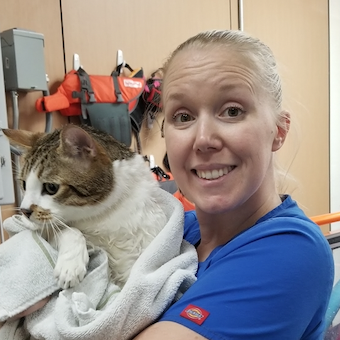Hey, future veterinary professional! Welcome to the world of veterinary medicine. ♥️
When I started out in veterinary medicine I didn’t even know what being a veterinary technician was. Everyone knows the veterinarian's job description and how to achieve that career goal, but no one really explains how to become a vet tech.
So, we dove deep into all the questions you may have and how to take that next step in your career!
How much does it cost to become a vet tech?
First, let's talk about money because, let’s be real, not everyone was blessed with a trust fund. (It’s me, I am extremely jealous of you and your trust fund).
To become a veterinary technician, you need to complete a 2- or 4-year accredited program.
Lucky for you, there are 230 accredited vet tech programs around the U.S. You have multiple options of where you could go (community college, public or private universities) and what degree, whether it be an associate’s or bachelor’s in veterinary technology. There are also veterinary technology programs that offer learning at a distance!
Veterinary Technology Associate’s Degree Costs
The cost range for a veterinary technician associate degree is $1,300 - $12,000 for in-state tuition and fees for residents.
If you are looking for out-of-state education, it could cost $8,000 - $30,000 for out-of-state tuition and fees.
Some examples of different programs and costs:
- Cedar Valley College, located in Dallas, Texas, offers tuition starting at $2,400 for residents or $8,280 for non-residents. They are a two-year veterinary tech program.
- Yuba College, located in Marysville, California, offers tuition starting at $1,240 for residents or $11,036 for non-residents. They are also a two-year veterinary tech program.
- Penn Foster College is an online veterinary tech program that is asynchronous. It usually costs around $1,200 per semester and can be completed in four semesters.
Veterinary Technologist Bachelor’s Degree Costs
You could also attain a bachelor's degree in veterinary technology, and the typical cost for that is $67,000- $86,000. There are currently 28 AVMA CVTEA- Accredited programs.
Some examples of different programs and costs:
- Mercy College, located in Dobbs, New York, costs around $68,360 for tuition and is a four-year program.
- University of Maine At Augusta Bangor Campus, located in Bangor ME, costs around $33,388 for tuition and is a four-year program.
- Florida A&M University, located in Quincy, Florida, actually has a wonderful net price calculator for an estimated cost and average of aid awarded. But, on average, it will cost around $26,569 for tuition and is a four-year program.
All programs listed are accredited by the AVMA.
Overall the cost varies from school to school, and the best way to find out the cost is to contact your school of choice directly.
Additional Academic Costs
Typically, veterinary school books and supplies could cost you anywhere from $1,500 - $3,600/year.
Licensing & VTNE Costs
Just like a veterinarian, to become a credentialed technician (registered, licensed, or certified, depending on where you live), a graduate must pass a state board test for licensure!
The VTNE
The exam veterinary technicians take is called the Veterinary Technician National Exam (usually called the VTNE).
It costs $345 dollars and consists of 150 operational questions and 20 pilot questions varying in point value.
Wait, what’s a pilot question?
The pilot questions are used as guidance for future examinations and do not count toward your final score. To learn more about the VTNE, I recommend heading to aavsb.org/VTNE.
Licensing Fee
There will also be a state licensure fee ranging from $177-$250, depending on what state you live in.
Can you be a vet tech without a degree?
In most states, you cannot become credentialed without graduating from an accredited vet tech program. But, some states allow an alternative route.
The VTNE “Alternate Pathway”
The loophole in this situation is called “The Alternate Pathway” to become eligible to take the VTNE. Only 3 states currently allow On-the-Job Training (OTJ) or alternate degrees for VTNE eligibility: Alaska, California, and Wisconsin.
In this case, you will have to fill out quite a bit of paperwork and have the qualifications in order to be eligible. I know many technicians that have received their licensure through this route and I myself have gone through it!
But, if you are in the position to attend a traditional vet tech program, I highly recommend doing so as the knowledge you gain is invaluable. Personally, I took the VTNE 3 times and did not pass with just my OTJ training.
Also, back in 2000, there was a ruling by the Association of American Veterinary State Boards (AAVSB) that within ten years they will no longer allow the VTNE to be taken under the alternate pathway nationwide. That’s why only 3 states still offer the route.
How do I get a veterinary job?
Now you know the nitty-gritty behind becoming a vet tech, but what about getting the job? Well, don’t worry there is a strong demand in the veterinary community for graduates from a vet tech program.
But, even prior to graduation, the demand for veterinary medicine for all positions is high. So, now is your chance to get your foot in the door and begin your journey!
What jobs are there for un-credentialed workers?
A few jobs you can look for are:
- Kennel Assistant/Technician: cleaning & maintaining kennels
- Client Services Rep/Customer Service Rep/Receptionist: greets & checks clients in at the front desk, answers phones and questions, helps with administrative tasks
- Veterinary Assistant: assists technicians and veterinarians with less technical tasks
- Uncredentialed Veterinary Technician: some states don’t require you to have your licensure to call yourself a “technician,” so if you live in one of those states, these jobs may be available to you as well!
As for my journey, I started in veterinary medicine as a Kennel Technician, then Client Services Rep for 1 year before ever stepping foot in the hospital setting of a veterinary clinic. Then, I went to the dark side (the clinical side) and never looked back! I was a Veterinary Assistant and then moved my way up the ladder to Veterinary Technician and eventually became a mentor for technicians as time went on!
Where should I look to find a veterinary job?
A great place to start is scout, a free job search platform exclusively for veterinary professionals!
Scout is particularly awesome for job seekers newer to the industry because it matches you with employers based on your preferences, not just your past experience, which may be limited.
You’re also able to explain more about yourself, denote if you’re a student, and search for jobs all across the U.S.!
You got this!
Veterinary medicine is an incredible industry, full of hardworking & passionate people - just like you. ♥️




.gif)


